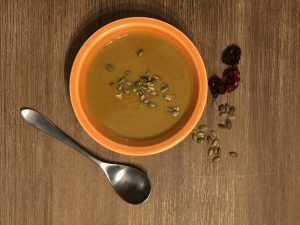How Assembling Care Providers Is Like Cooking a Delicious Soup

I walk my standard poodle, named Lenny Bruce, around the neighborhood every afternoon. We live in a historic area of Des Moines, Iowa, with sturdy sidewalks and old, expansive trees. Over the last week, I have relished the transformation of summer giving way to autumn.
There’s an emerging crispness in the air, and leafy green colors are igniting to shades of yellow, orange, and red. I inhale deeply and detect a hint of smoke on the wind, as the earliest of fallen leaves give a satisfying crunch under my feet. I admire skeletons popping up from front yard topsoil or hanging from low tree branches, pumpkins lovingly displayed on front stoops, and autumn mums bursting with color.
It makes me crave a big bowl of soup.
There is nothing quite like the ritual of making that first pot of soup every autumn. I explore the produce department (this year, I did so virtually) to see what color or shape of gourd catches my eye, or I follow the recommendations of friends, my favorite source of recipes. I consider each ingredient, as well as the texture and taste it will add.
As I unloaded the contents of my grocery bag onto the counter earlier this week, it occurred to me how similar cooking a great recipe is to the process of assembling healthcare providers to manage my chronic condition.
I have acute intermittent porphyria. Is it a liver disease? A blood disorder? A central nervous system condition? A metabolic disorder? Yes. It’s a complicated and rare condition, which cannot be effectively managed from a single lens or medical perspective. Rather, I have gathered an entire group of practitioners to help me find balance and my most delicious life.
Sports analogy is a popular way to describe this compilation of care specialties; for instance: a “team” of doctors. As a person with acute hepatic porphyria, my “quarterback” doctor may be a hematologist or a primary care physician. As a fan of “sportsball” (“Do the thing, win the points!”), this metaphor doesn’t speak to me. Besides, if it’s my doctors who make up the team, where does that leave me? Am I the spectator … or the ball? I prefer to think of myself as a cook, assembling ingredients for a yummy recipe of care provider soup.
Shortly after diagnosis, I saw one national porphyria expert annually and a local specialist monthly, both hematologists. Over a couple of years, this routine became increasingly frustrating, as I wanted both of them to have an answer for everything. Why is my neuropathy increasing? What can I do about my chronic muscle tightness and pain? Why can’t I sleep even just a little bit at night?
I channeled my energy and sought out others who have chronic symptoms and frequent attacks. From those people, I learned targeted and coordinated care from a variety of providers was critical to living their most fulfilled, nourished life. I began to shop for my own recipe, knowing that like a good soup, the right ingredients are critical.
Every soup needs a solid stock, so I started with a primary care physician who came highly recommended by a friend with multiple sclerosis. When I met with this physician for the first time, I brought a worksheet I had created, with an empty box for each area of health specialty I needed to fill. Those first few visits were foundational for our patient-provider relationship, but they also helped me collect and combine ingredients for my care team soup.
While physical health is critical, my recipe also calls for mental and alternative health components — these are the spices! I can survive without them, but the flavor is dull, lacking and may never fully come together, especially if I lose my focus on mental health.
Like any good recipe, it’s not just about shopping for and trying ingredients. The prep work, amounts, order of inclusion, and whole process must be considered. For instance, sometimes all I need is a dash of massage or a pinch of physical therapy; sometimes I need more of both.
Most important to any care provider recipe is understanding that we are the cooks. Each of our circumstances are special, and we all have different needs and specific tastes. What works for one chronically ill patient may not work for me, even if our diagnoses lines up. Remember, we know better than anyone what makes us feel better, and we get to choose our flavors.
This year, my first autumn soup is a dairy-free curried butternut squash soup recommended by a girlfriend. Just as I can count on it to warm me up after a walk with Lenny, I’m looking forward to the ritual of cooking the recipe and sharing its nourishment with my family.
***
Note: Porphyria News is strictly a news and information website about the disease. It does not provide medical advice, diagnosis, or treatment. This content is not intended to be a substitute for professional medical advice, diagnosis, or treatment. Always seek the advice of your physician or other qualified health provider with any questions you may have regarding a medical condition. Never disregard professional medical advice or delay in seeking it because of something you have read on this website. The opinions expressed in this column are not those of Porphyria News or its parent company, Bionews, and are intended to spark discussion about issues pertaining to porphyria.








Comments